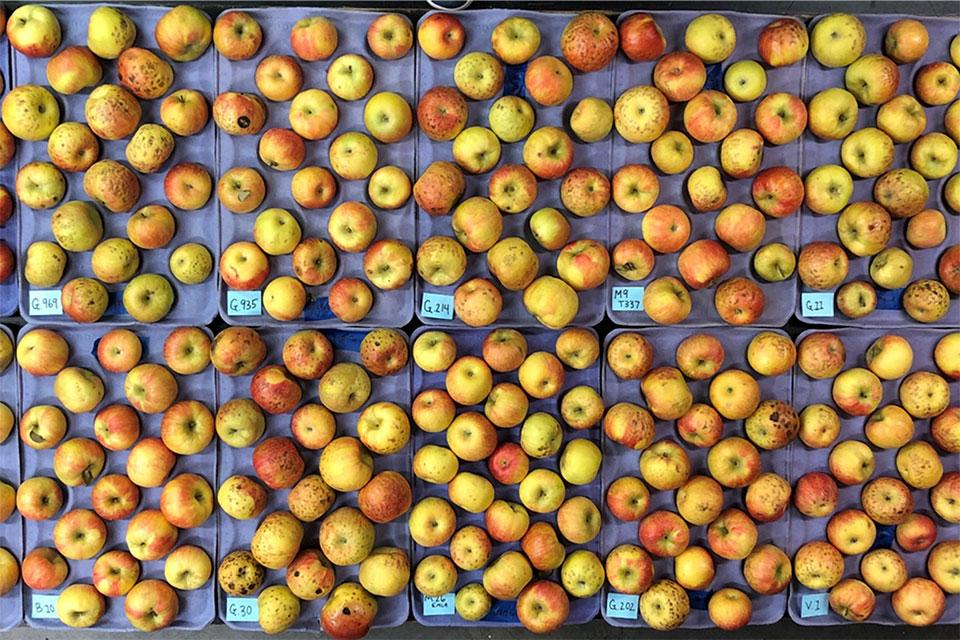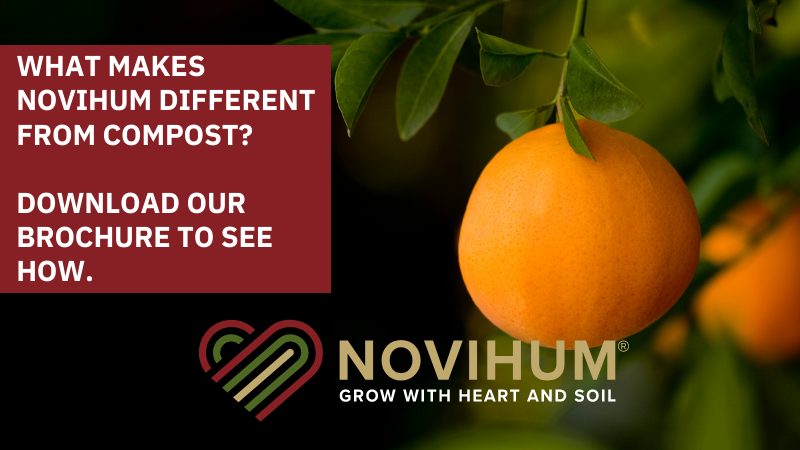Big Breakthrough When It Comes To Bitter Pit and ‘Honeycrisp’ Apples

Seen here are the disparate effects of various rootstocks on bitter pit incidence following cold storage. B.10 rootstock (bottom left) scored best in bitter pit incidence.
Photo by Sherif Sherif, Virginia Tech’s Alson H. Smith Jr. AREC, Winchester, VA
‘Honeycrisp’ trees on Budagovsky.10 (B.10) rootstock boasted the lowest bitter pit (BP) incidence, whereas those on Vineland (V).6 rootstock exhibited the highest, according to a study published in the journal Frontiers in Plant Science.
The trial, conducted at Saunders Brothers Orchard in Piney River, VA, demonstrates the significant effect rootstocks can have on BP incidence in ‘Honeycrisp’ apples at harvest and after cold storage.
“Our research, spanning four seasons, endeavored to scrutinize the impact of 14 distinct rootstocks on the incidence of bitter pit, both at the time of harvest and following a three-month period of cold storage,” says senior author Sherif Sherif, an Associate Professor and Tree Fruit Physiologist at Virginia Tech. “Our observations suggest that B.10 rootstock led to the minimum percentage of bitter pit incidence during both instances, whereas rootstocks from the Vineland series bore the highest percentage.”
Interestingly, Sherif notes, none of the Geneva (G) rootstocks examined in the study, such as G.11, G.30, G.41, G.202, G.241, G.935, and G.969, performed on par with B.10.
The investigation also revealed a noteworthy variation in mineral content, according to Sherif. Fruits cultivated on B.10 rootstocks exhibited higher concentrations of calcium (Ca), coupled with lower levels of potassium and magnesium, in contrast to fruits grown on susceptible rootstocks, which exhibited an opposing trend.
“The honor of our study’s inclusion in a distinguished journal is attributed to our discovery that the ratio of cell wall-bound calcium to total calcium was found to be lower in fruits cultivated on B.10, as compared to other rootstocks,” Sherif says. “This suggests that the amount of free calcium, a component integral to cell viability, is relatively higher in fruits on B.10 rootstocks. Furthermore, our research underscores the need to evaluate free calcium, rather than total calcium, in future bitter pit studies.”
STUDY PARAMETERS
Sherif’s research associates at the Alson H. Smith Jr. Agricultural Research and Extension Center in Winchester, VA — namely Tabibul Islam, Protiva Rani Das, and Jianyang Liu — co-authored the study. Amritpal Singh, a researcher affiliated with Agriculture and AgriFood Canada, contributed to the findings.
“As the designated representative of the NC-140 project in Virginia, I have had the privilege of collaborating with esteemed horticulturists across various states in the U.S. and Canada,” Sherif says. “Our collective endeavor involves the meticulous assessment of dwarfing and semi-dwarfing apple rootstocks, investigating their impact on the growth and yield attributes of commercial apple cultivars. In light of this, my research team has made a strategic choice to embark on a novel exploration, utilizing the existing plantation to scrutinize the influence of rootstocks on the occurrence of bitter pit — a prevalent physiological disorder in ‘Honeycrisp’.”
Previous investigations had suggested rootstocks could affect the development and severity of BP, which often appears during or after cold storage. Despite being defined as a Ca deficiency disorder, BP is a complex process that is not only affected by the total Ca content in the fruit but also
by the proper cellular Ca homeostasis and partitioning.
In this latest study, rootstock effects on BP development were assessed on ‘Honeycrisp’ trees grafted on 14 rootstocks — B.10, (G).11, G.202, G.214, G.30, G.41, G.935, G.969, Malling (M).26 East Malling/Ashton Long (EMLA), M.9, V.1, V.5, V.6, and V.7.
‘Honeycrisp’ apples were collected from three of those rootstocks (B.10, G.41, and V.6) two months after cold storage and evaluated for mineral nutrient composition, Ca homeostasis, and cell wall properties, including pectin content, pectin de-esterification rate, and pectin methylesterase (PME) activity.
Sherif and his group also observed increased PME enzyme activity and a greater degree of water-insoluble pectin de-esterification in ‘Honeycrisp’ apples from V.6 compared to those from B.10.
“The process of de-esterification enhances the pectin’s ability to bind more calcium, resulting in a reduction of free calcium, which is the more biologically active form necessary for maintaining cell integrity,” Sherif says. “This explains why fruits on B.10 rootstocks exhibited lower levels of PME activity, which is responsible for de-esterification.”
Indeed, Sherif and his group reported the ratio of cell wall-bound Ca to total Ca was lower in B.10 compared to G.41 and V.6.
“Our research arrived at these consequential findings by examining both forms of Ca, rather than solely quantifying the total Ca in fruit peels as previous horticulturists have done,” Sherif says. “This approach should be adopted in future studies on bitter pit to advance our understanding in this field.”
B.10 Rootstock Sidenote
Sherif indicates that his observations regarding B.10 are not surprising, considering that B.9 is one of B.10’s parents.
“Almost all growers in the Mid-Atlantic can attest to the same sentiment, recognizing B.9 as the most optimal rootstock for ‘Honeycrisp’ in terms of reducing bitter pit incidence,” he says. “However, they also emphasize that, regardless of soil type or orchard practices, B.9 trees are notably dwarfing and require careful management to occupy the designated space and reach the highest wire.”
Sherif’s extensive experience of more than seven years working on this planting while meticulously recording data on rootstock effects on tree vigor led him to find that B.10 yields relatively more vigorous trees compared to B.9 while achieving a size comparable to M.9.










